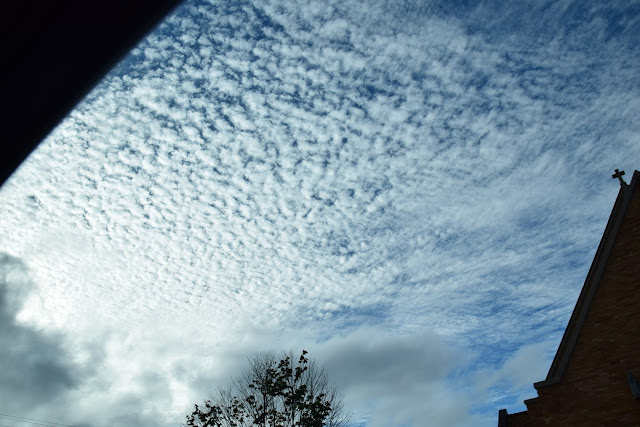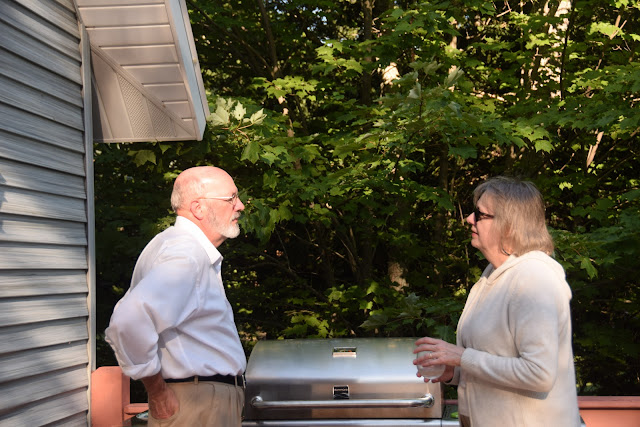Note: As one of my
summer reading projects, I researched
the World War II massacre of the town of Jedwabne in eastern Poland on July 10,
1941 . The massacre at Jedwabne gained
attention with the publication of Jan T. Gross’s Neighbors. The book sparked
a great deal of controversy in Poland and elsewhere and revealed fissures still
present in Polish memory of World War II.
At the end of my reading, I decided I wanted to try to write about my
response, basically as a way to think through the material I had read. I am
posting this to my blog because
it does show a different
kind of reading in retirement, and
because I like to write about important things I read.
Neighbors: The
Destruction of the Jewish Community in Jedwabne Poland. Jan T. Gross
Princeton University Press. 2001.
The Crime and the Silence: Confronting the Massacre of Jews
in Wartime Jedwabne. Anna
Bikont. Farrar, Strauss and Giroux,
2004.
The Neighbors Respond:
The Controversy Over the Jedwabne Massacre in Poland. Ed. Anthony Polonsky and Joanna B. Michelin. Princeton University Press, 2004.
As I remarked earlier on the blog, I have been recently read
a number of books in which the writer tries to discover the identity and fate
of individuals who perished in the Holocaust, primarily in eastern Poland. But as I read these books, I was also reading
about a particular town which has become infamous for what the historian Jan
Gross describes as a day in July 1941 when “half the population of a small
eastern European town murdered the other half.”
The town was Jedwabne, a small community in Eastern Poland that had been
occupied briefly by the Nazis until the German-Soviet Treaty was signed in
1939, then occupied again after the outbreak of the Russian-German war in June
1941.
What happened at Jedwabne became a hugely controversial
issue in Poland after the publication of
Neighbors. According to Gross, a group of citizens of
Jedwabne and neighboring communities rounded up the Jedwabne Jews on July 10,
1941. Most were gathered in the town
square. Some were killed in the square,
some in other parts of Jedwabne, and
many were marched into a barn which was then set on fire. Several Nazis were there to film the
activities, but the killing was done solely by the non-Jewish Polish population
of the town. Also present, according to
Gross, were families in wagons from neighboring villages who had prior
knowledge of the Jedwabne pogrom and had come ready to loot the empty Jewish
houses. At the end of the day,
Jedwabne’s Jewish population—Gross estimates it as 1600 men, women and
children—was virtually decimated.
The fact of the Jedwabne massacre is undisputed, but what
remains contested in Gross’s account, by many of his Polish readers, is his
claims that the German soldiers had no part in the killings; that the Polish
killers were not coerced; that Jews were killed because of Poland’s historical
anti-Semitism, not because they had purportedly collaborated with the
Russians in the period between the two Nazi occupations; and that the Catholic
priest in Jedwabne gave tacit approval and encouraged anti-Semitism (a charge
Gross further levels against the Catholic church as a whole).
Published first in Polish and then English, Neighbors was (is) extremely
controversial in Poland. This controversy
has played out in terms of the degree to which the Nazis were (or were not)
involved in the massacre, the degree to which the Catholic church supported
Polish anti-Semitism, the historical depth of Polish anti-Semitism, the
relative status of “victim” in Poland during World War II, the appropriate way
to memorialize the event, and most importantly whether living Poles who were
not a part of Polish pogroms bore any collective responsibility for what
happened.
The complications of
understanding, much less accepting, what occurred at Jedwabne on July 10, 1941 is
the subject of Anna Bikont’s book The
Crime and the Silence. Bikont, a
journalist, spent 2001 and 2002 interviewing people about Jedwabne. These interviews included Jedwabne citizens
who had witnessed the massacre first hand, including the one surviving man who
had been among the 10 men convicted of the crime in the trial held by the
Russians in 1953 (all but one of whom received sentences of 5 to 10 year) and
the few Jews who had escaped Jedwabne or the neighboring village Radzilow which
was the site of a pogrom on July 7, 1941; the then-mayor of Jedwabne and
members of the town council who were engaged in the controversy about how to
memorialize the killings; and the prosecutor from the Polish Institute of
National Memory, who was charged with investigating the case after the
publication of Neighbors. What astonishes about her book is her
inability to get almost anyone to talk about the event or to accept what seem
to be uncontroverted facts including the following: 1) that while there were German soldiers at
Jedwabne during the pogrom there is no evidence that they were there in any
number and the only actions they seem to have taken were photographing the
events; 2) that even though the exact number of victims will never be known
(1600? 900?), the whole of the Jewish
population was killed on that day; 3) that the majority of victims had not earlier
collaborated with the Soviets by targeting Polish citizens; 4) that looting had
occurred during and after the massacre; 5) that the Polish killers had not been
coerced; and most alarmingly, 6) that present-day Poles bore no responsibility
not just for Jedwabne but for the many Polish-initiated killings in World War II.
(There had been pogroms in nearby villages in the days surrounding the
Jedwabne massacre.) Even the woman credited with saving one of the survivors was afraid to speak because she feared repercussions from other inhabitants of Jedwabne, sixty years after the event.
Among the exceptions to this willed silence were the
then-mayor of Jedwabne, who tried to work with Jewish leaders and other
concerned Poles to mark the 60th anniversary of the Jedwabne
killings, including changing the memorial stone which then said that here the
Nazis killed 1600 Jews (the mayor has since been voted out of office; a few former
Jedwabne citizens; the few survivors of Jedwabne, and the Polish Institute for
National Memory.
Because it was written just after the publication of Neighbors and just before the 60th
anniversary of the Jedwabne massacre, a good deal of Bikont’s book concerns debates about how to
memorialize the event. The Jedwabne
Town Council—with the exception of the mayor and one other
member—wanted the city to have no official part in the memorial service, even
though they accepted funds to repair the streets to accommodate visitors. The Catholic church, including the local
priest, did not participate, though there was a smaller service in Warsaw on
another date. And almost no local
citizens were there. A group of Jewish
rabbis from the United States, including
one who had grown up in Jedwabne but left before the war were there, as were
other international visitors. Also
present was the President of Poland who apologized in the name of the Polish
people.
Bikont’s book is vivid example of books of a certain
Holocaust genre: the attempt to locate
the identities, actions, and fates of specific victims. The book alternates excerpts from Bikont’s
journal during the two years she spent researching, and mini-biographies of
people who had a part in the Jedwabne pogrom.
The book thus tells two stories:
one, Bikont’s two year journey
(though Poland and several other countries) to track down “what happened,” and
2), the story of what happened,” to the degree it can be known The book ends
with the National Institute of History’s prosecutors statement that “The
perpetrators of the crime, strictly speaking, were the Polish inhabitants of
Jedwabne and its surroundings—a group of at least forty men.”
The closure promised in the statement of the Prosecutor has not been achieved in
regards to Jedwabne. Controversy remains
about almost all the fundamental questions—how many victims, how many Nazis,
how many Poles. The degrees of controversy
and kinds of arguments are ranged in a collection of primary sources about the
debate reproduced in The Neighbors
Respond. These include sections of
articles about the following topics: the
initial reporting of Gross’s allegations, the moral debate, official
statements, the debate in the Catholic church, voices of Jedwabne’s
inhabitants, historical methodologies, and the response outside Poland. This
volume makes clear that important questions still survive in Poland about Polish social memory and national
identity. It also clearly documents that
anti-Semitism is still a powerful force in Polish society, though its depth and
nature are highly debated topics. And it
challenges how history is made about events, such as the Holocaust, where
almost none of the victims themselves survived.
Jedwabne is a metonym for Polish-Jewish relations—before,
during, and after World War II As the
controversy it inspired makes clear, more is at stake than the history of one
small village. Jedwabne became a
touchstone for complex questions about Polish identity—national, historical,
ethnic—that appear to be as yet unanswered.
However what remains is the stark knowledge that, in the
words of Hanna Swida-Ziemba from The
Neighbors Respond: “Regardless of
whether there were more or fewer Germans in Jedwabne, whether 1,632 or
significantly fewer (say, for example, 933) were burned in that barn, how many Poles
took part in it, and whether the Germans played the role acquiescent observers
or active provocateurs, nothing will change the simple truth, cruel for us today, that all [sic]*
the residents of Jedwabne were burned alive, and that the crime was committed
by the local population.”
* It is now known
that most of the people burnt in the barn were women, children and the elderly;
men and older boys were killed elsewhere and there corpses placed in the
barn.
#Jedwabne
#Neighbors
#JanTGross
#AnnaBikont
































